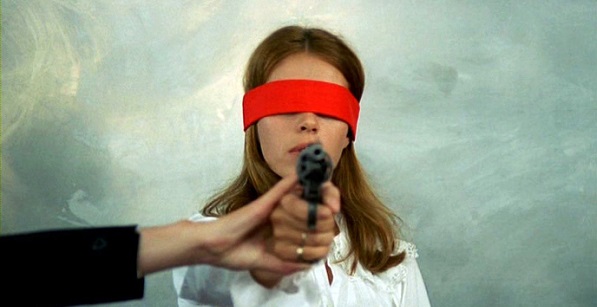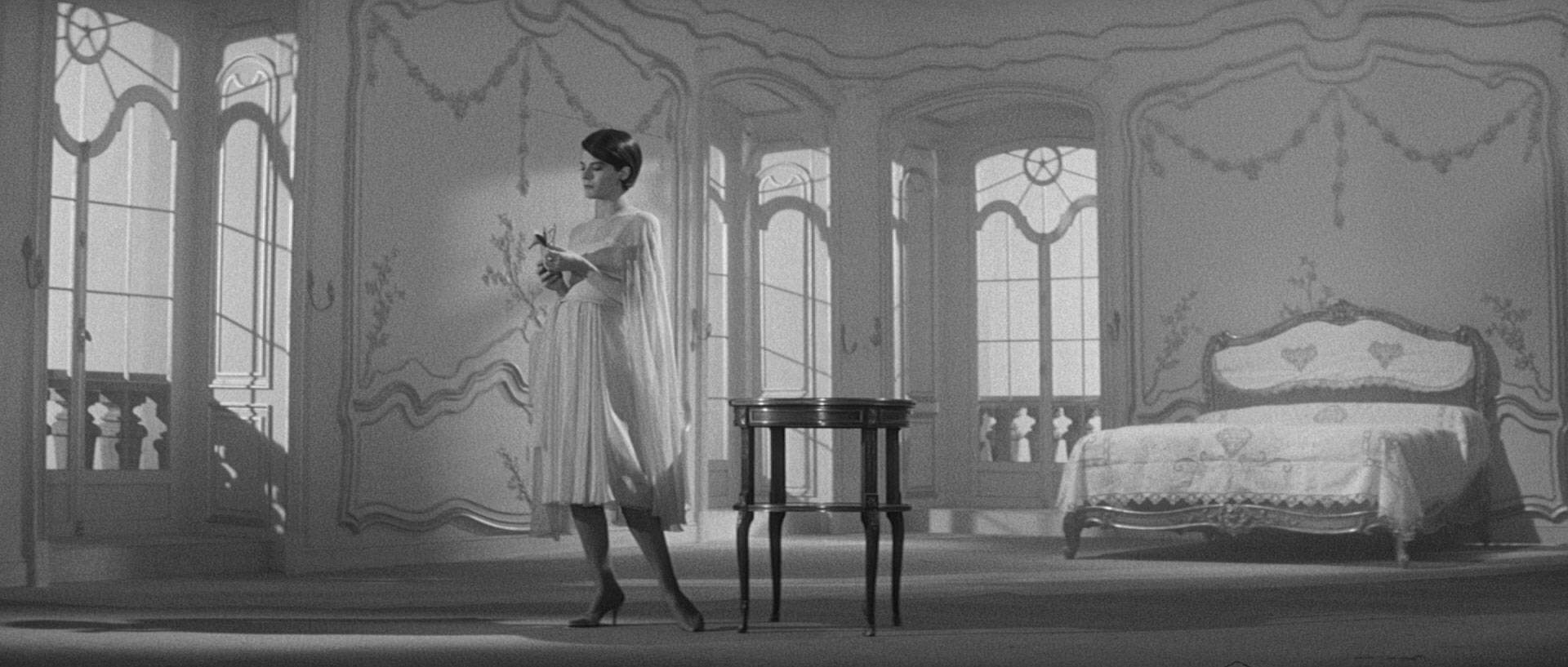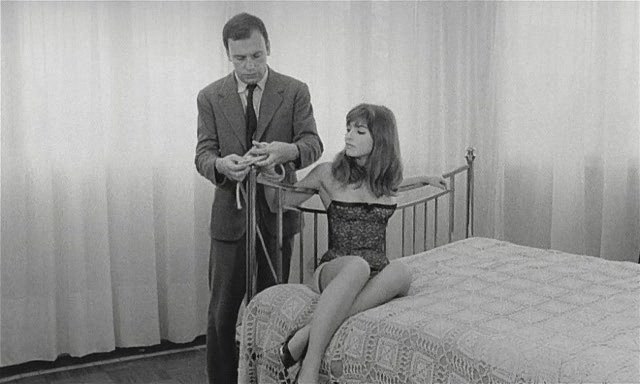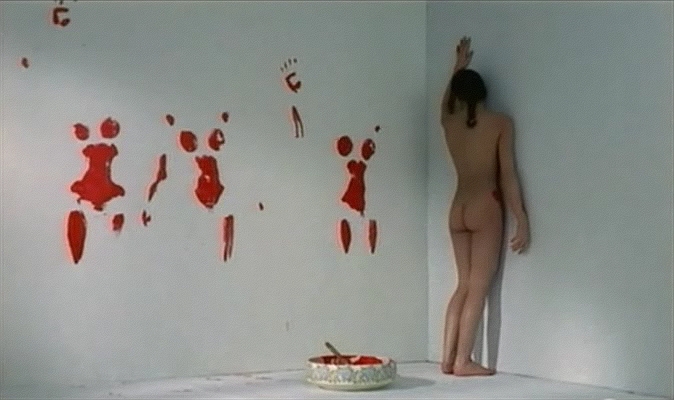“The essential characteristic of the image is its presentness. . . .What we see on the screen is in the act of happening, we are given the gesture itself, not an account of it.” So wrote Alain Robbe-Grillet of Last Year at Marienbad—his first film made in collaboration with director Alain Resnais. Sleek and sophisticated as the adventure-romances Josef von Sternberg made with Marlene Dietrich in the 1930s, yet as inscrutably avant-garde as The Cabinet of Dr. Caligari (1919) and Un chien Andalou (1929), it was quite the novelty in 1961, when gritty realism was the coin of the cinematic realm.
Scrumptiously photographed by Sacha Vierny in lush high-contrast black and white, with gorgeous gowns by Coco Chanel plus a striking Louise Brooks-inspired hair-do for leading lady Delphine Seyrig that was quickly copied by everyone from Gloria Vanderbilt (in real life) to Marian Seldes (on stage in Edward Albee’s existential drama A Delicate Balance), Marienbad offered upper-crust moviegoers a ninety-three minute escape into a dream world of European chateaus (several were used to create the immense spa where the minimal plot unfolds) where the world’s oldest pick-up line (“Haven’t we met somewhere before?”) took the form of a kind of puzzle the spectator was invited to figure out. Did “A” (Seyrig) meet “X” (the dashing Giorgio Albertazzi) at this luxury haunt the year before, or was he making it up the better to lure her into running away with him? And what of “M” (Sacha Pitoeff) “A’s” lover/ husband/ keeper? What was their relationship about? Why were he and ”X” constantly playing a parlor game with matchsticks—and why was he always losing? Needless to say there were no more answers to these questions than there were three-dimensions to the characters of “A,” “X” and “M.” Yet it all somehow satisfied art house cinema sensibilities to the max.
It was no surprise that after this triumph Robbe-Grillet would, like Resnais collaborator Marguerite Duras, strike out to make films on his own. But the twelve features Robbe-Grillet wrote and directed post-Marienbad are quite unlike the film that launched his moviemaking career. Only one of these won anything resembling widespread success—the others languishing in undeserved neglect in very select art houses. Why this came to be the case is a bit harder to fathom, as the new Kino-Lorber/Redemption series bringing six of his best films—L’Immortelle (1963), Trans-Europ Express (1967), The Man Who Lies (1968), Eden and After (1970), N a pris les de (1971) and Successive Slidings of Pleasure (1974) to DVD and Blu-ray for the first time (each equipped with introductory interviews with the auteur) spectacularly demonstrates.
All six films are more modestly produced than Marienbad. And while two star Jean-Louis Trintignant (who also appears as a kind of “guest star” in Successive Slidings of Pleasure) the lion’s share of attention is given to such newcomers as Catherine Jourdan (Eden and After and N a pris les de) and Anicee Alvina (Successive Slidings of Pleasure.) This would suggest a quasi-feminist imperative. But few feminists would approve of what Robbe-Grillet does with his actresses, who are not only sexually “objectified” but displayed naked and tied with ropes and chains while doing so. Clearly we’re a long way the romantic politesse of Marienbad. Add to that recurrent sequences of murder by strangulation and/or attacks via knife and (in the case of Successive Slidings) scissors and you’ve got yourself a cinema that’s more than a tad problematic.
Was Robbe-Grillet aiming for an audience of male collectors of Bettie Page bondage erotica? If so they were likely to find themselves confused by narratives that never establish any clear sense of plot. Francoise Brion looks lovely in her lacy undies in L’Immortelle. But what’s devotee of “Swank” to make of her largely inert form and Jacques Doniol-Valcroze’s baleful stares? Trans-Europ Express (the most critically and commercially successful of Robbe-Grillet’s films) is exceptionally playful in that it centers on Robbe-Grillet his wife Catherine and a producer friend riding the title train and concocting a screenplay for Trintignant to act it. Yet nothing about this “story” is settled. Our anti-hero could be smuggling diamonds or drugs. The mystery woman he meets up with (Marie-France Pisier) may be a secret agent, or a police spy or simply a local streetwalker. Likewise we see her die only to return at the film’s finale as . . .Marie-France Pisier.
This self-same lack of narrative resolve figures in The Man Who Lies where Trintignant is playing both a resistance hero and his assassin. But this Czechoslovakia-shot jape is a simple affair compared to Eden and After and its re-edited version N a pris les de (its title an obvious reference to Mallarme’s Un coup des de jamais n’aboolira le hazard ) in which Catherine Jourdan may be leading a group of post-May ’68-style revolutionaries or is a freelance S&M submissive out for kicks. As outré as these exotic doings may be (shot like L’Immortelle in Pierre Loti-inspired eastern locales) they’re relatively reserved alongside Successive Slidings of Pleasure in which Anicee Alvina plays a pretty young miss who may have killed her lesbian lover (Olga-George Picot). She and her lawyer (also played by Picot) are awaiting a police inspector (Trintignant) before whom they will “re-enact” the crime. But being a Robbe-Grillet film, said “re-enactment” is simply a repetition. And its safe to say there’s nothing in cinema quite like the sight and sound of Anicee Alvina whispering softly in Olga-George Picot’s ear “You are going to die” as the latter bleeds to death.
A kind of anti-Marienbad, Successive Slidings of Pleasure is composed of images that are deliberately depth-free, simple and (being that they’re primarily filmed in “two-shot”) disturbingly intimate. It’s this disturbance, quite at odds with Marienbad’s chic, that Robbe-Grillet brought to the cinema. As his best films were released primarily in the 1970s where the realism of Bertolucci’s Last Tango in Paris and Oshima’s In the Realm of the Senses predominated, and mass-market “erotica” was exemplified by the perfumed softcore of Emmanuelle, these films were lost in the shuffle. Thank goodness for this splendid opportunity to unshuffle the deliciously disturbing Alain Robbe-Grillet.







